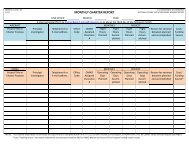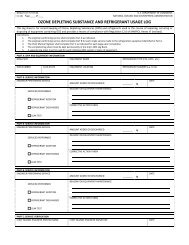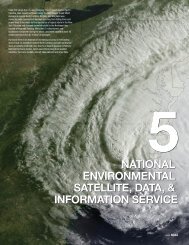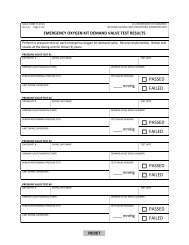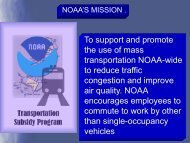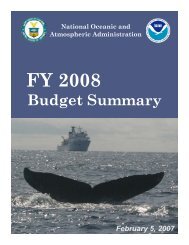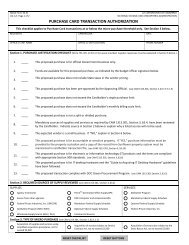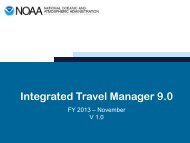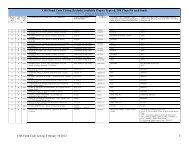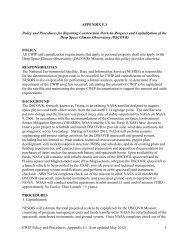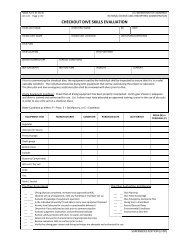Chapter 3: NOAA Procurement, Acquisition and Construction
Chapter 3: NOAA Procurement, Acquisition and Construction
Chapter 3: NOAA Procurement, Acquisition and Construction
You also want an ePaper? Increase the reach of your titles
YUMPU automatically turns print PDFs into web optimized ePapers that Google loves.
CHAPTER 3<br />
<strong>NOAA</strong> procurement, acquisition, & construction<br />
(BA in Thous<strong>and</strong>s)<br />
New Vessel <strong>Construction</strong><br />
(FSV5)<br />
FY 2011<br />
Request FY 2012 FY 2013 FY 2014 FY 2015<br />
3,000 0 0 0 0<br />
New Vessel <strong>Construction</strong> FSV5: <strong>NOAA</strong> requests an increase of $3,000,000 <strong>and</strong> 0<br />
FTEs to design a new shallow-draft Fisheries Survey Vessel (FSV 5). <strong>NOAA</strong> plans to<br />
modernize its fleet, consistent with <strong>NOAA</strong>’s Ship Recapitalization Plan (SRP), <strong>and</strong> addresses<br />
the oldest vessels <strong>and</strong> those at-sea requirements most at risk first. A shallow-draft FSV<br />
will be needed to replace Oregon II which is among the oldest ships in the <strong>NOAA</strong> Fleet at<br />
44 years of service life by FY 2011. Oregon II is an Oscar Dyson class vessel (FSV1-FSV4)<br />
which has a draft of 19 feet <strong>and</strong> 29 feet with the scientific center-board extended. The draft<br />
limits the ability to conduct living-resource <strong>and</strong> coral-habitat surveys in waters shallower<br />
than 42 feet, making it unsuitable to operate in the Gulf of Mexico. The shallow-draft FSV<br />
will operate in near-shore coastal waters as shallow as 30 feet <strong>and</strong> is intended to be the<br />
primary ship supporting Gulf of Mexico living-marine resource, habitat, <strong>and</strong> integratedecosystem<br />
surveys. The funding for additional design work would leverage existing<br />
designs while developing a shallow draft vessel to meet these requirements. Data from<br />
these cruises are critical to assessments of the snapper-grouper complex, billfish, tunas,<br />
swordfish <strong>and</strong> sharks, <strong>and</strong> status of protected species, habitat, <strong>and</strong> ecosystem health. From<br />
FY 2000 to FY 2006, Oregon II lost an average of 19 days of operation each year due to<br />
engineering related problems. If a suitable replacement ship is not acquired, Oregon II will<br />
reach the end of its useful service life <strong>and</strong> will be removed from service in FY 2016.<br />
(BA in Thous<strong>and</strong>s)<br />
Fisheries Survey Vessel<br />
(FSV 6)<br />
FY 2011<br />
Request FY 2012 FY 2013 FY 2014 FY 2015<br />
1,400 1,400 2,900 0 0<br />
New Vessel <strong>Construction</strong> FSV6: <strong>NOAA</strong> requests an increase of $1,400,000 <strong>and</strong> 0<br />
FTE to provide project management <strong>and</strong> change margin funds for Fisheries Survey<br />
Vessel (FSV6). FSV6 will replace David Starr Jordan <strong>and</strong> perform acoustic surveys for fish<br />
<strong>and</strong> zooplankton <strong>and</strong> launch <strong>and</strong> recover a work boat in open seas. <strong>NOAA</strong> requires data<br />
collected at sea to achieve outcomes m<strong>and</strong>ated by Congress <strong>and</strong> the economic impact is<br />
significant. The Magnuson-Stevens Fisheries Conservation <strong>and</strong> Management Reauthorization<br />
Act require sufficient data to establish annual catch limits for fisheries. If sufficient data<br />
is not available, catch limits must be reduced from current levels with an estimated negative<br />
impact on the commercial fishing industry of up to $7 billion annually. With this increase<br />
OMAO will procure continuity in the civilian expertise required to monitor <strong>and</strong> evaluate the<br />
contractor’s progress during construction. The requested funding is necessary to complete<br />
construction <strong>and</strong> bring FSV6 into operations.<br />
3-93




